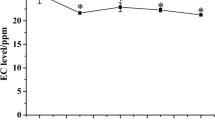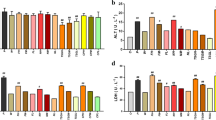Abstract
Backgrounds
Paraquat is toxic to humans and there is no antidote for paraquat poisoning. Moreover, the mechanisms of paraquat toxicity have not been clearly defined.
Methods
In this study, we developed a serum metabolomic method using gas chromatography- mass spectrometry (GC-MS) to evaluate the effects of paraquat poisoning on mice. Pattern recognition analysis, including both principal component analysis and cross orthogonal partial least squares-discriminate analysis revealed that paraquat poisoning induced energy/redox cycle and metabolic perturbations.
Results
Compared with the control group, the levels of creatinine, citric acid, succinic acid, fumaric acid and glycine in the sub acute paraquat poisoning group increased (P < 0.05), while the levels of alpha-Tocopherol, 6-phosphogluconic acid and palmitoleic acid decreased (P < 0.05).
Conclusion
These findings provide an overview of systematic responses to paraquat exposure and metabolomic insight into the toxicological mechanism of paraquat. Our results demonstrate that the metabolomic method based on GC-MS can be a useful tool to elucidate the mechanism of PQ toxicity, and provide a new direction for its clinical diagnosis and treatment.
Similar content being viewed by others
References
Bus, J. S., Cagen, S. Z., Olgaard, M. & Gibson, J. E. A mechanism of paraquat toxicity in mice and rats. Toxicol Appl Pharmacol 35, 501–513 (1976).
Bullivant, C. Accidental poisoning by paraquat:report of two cases in man. Br Med J 1, 1272–1273 (1966).
Wan, X. et al. Metabolic profiling of amino acids associated with mortality in patients with acute paraquat poisoning. Med Sci Monit 24, 1397–1407 (2018).
Tabata, N. et al. Paraquat myopathy: report on two suicide cases. Forensic Sci Int 100, 117–126 (1999).
Haddad, L. M. & Winchester, J. F. in Clinical Management of Poisoning and Drug Overdose (ed. Winchester, J. F.) 1088–1103 (Philadelphia, W. B. Saunders, 1990).
Mallat, E., Barzen, C. & Abuknesha, R. Fast determination of paraquat residues in water by an optical immunosensor and validation using capillary elextrophoresis-ultraviolet detection. Anal Chim Acta 427, 165–171 (2001).
Wang, Z. et al. Serum metabolomics in rats after acute paraquat poisoning. Biol Pharm Bull 38, 1049–1053 (2015).
Lii, C. K., Wang, S. T. & Chen, H. W. The detection of S-glutathionation of hepatic carbonic anhydrase III in rats treated with paraquat or diquat. Toxicol Lett 84, 97–105 (1996).
Kind, T. et al. FiehnLib: mass spectral and retention index libraries for metabolomics based on quadrupole and time-of-flight gas chromatography/mass spectrometry. Anal Chem 81, 10038–10048 (2009).
Zhang, G. C., Wang, Y. Q. & Zhang, H. M. Human serum albumin interaction with paraquat studied using spectroscopic methods. Pestic Biochem Phys 87, 23–29 (2007).
Wang, X. et al. Metabolic changes in paraquat poisoned patients and support vector machine model of discrimination. Biol Pharm Bull 38, 470–475 (2005).
Kwon, H., Park, J., An, Y., Sim, J. & Park, S. A. Smart-phone metabolomics platform and its application to the assessment of cisplatin-induced kidney toxicity. Anal Chim Acta 845, 15–22 (2014).
Wang, X. et al. Metabolic changes in paraquat poisoned patients and support vector machine model of discrimination. Biol Pharm Bull 38, 470–475 (2015).
Gibson, G. E. et al. Deficits in a tricarboxylic acid cycle enzyme in brains from patients with Parkinson’s disease. Neurochem Int 43, 129–135 (2003).
Yin, F., Boveris, A. & Cadenas, E. Mitochondrial energy metabolism and redox signaling in brain aging and neurodegeneration. Antioxid Redox Signal 20, 353–371 (2014).
Anandhan, A. et al. Glucose metabolism and AMPK signaling regulate dopaminergic cell death induced by gene (α-synuclein)-environment (paraquat) interactions. Mol Neurobiol 54, 3825–3842 (2017).
Lei, S. et al. Alterations in Energy/Redox Metabolism Induced by Mitochondrial and Environmental Toxins: A Specific Role for Glucose-6-Phosphate-Dehydrogenase and the Pentose Phosphate Pathway in Paraquat Toxicity. ACS Chem Biol 9, 2032–48 (2014).
Cantu, D., Fulton, R. E., Drechsel, D. A. & Patel, M. Mitochondrial aconitase knockdown attenuates paraquat-induced dopaminergic cell death via decreased cellular metabolism and release of iron and H2O2. J Neurochem 118, 79–92 (2001).
Osakada, F. et al. Neuroprotective effects of alpha-to-copherol on oxidative stress in rat striatal cultures. Eur J Pharmacol 465, 15–22 (2003).
Soares, D. G., Andreazza, A. C. & Salvador, M. Sequestering ability of butylated hydroxytoluene, propyl gallate, resveratrol, and vitamins C and E against ABTS, DPPH, and hydroxyl free radicals in chemical and biological systems. J Agric Food Chem 51, 1077–1080 (2003).
Roede, J. R., Uppal, K., Park, Y., Tran, V. & Jones, D. P. Transcriptome-metabolome wide association study (TMWAS) of maneb and paraquat neurotoxicity reveals network level interactions in toxicologic mechanism. Toxicology Reports 1, 435–444 (2014).
Gitto, E., Pellegrino, S., Gitto, P., Barberi, I. & Reiter, R. J. Oxidative stress of the newborn in the pre- and post-natal period and the clinical utility of melatonin. J Pineal Res 46, 128–139 (2009).
Mohamed, F. et al. Kidney damage biomarkers detect acute kidney injury but only functional markers predict mortality after paraquat ingestion. Toxicol Lett 237, 140–150 (2015).
Silfeler, I. et al. Protective effect of ellagic acid on paraquat-induced kidney hazards in rats. Iran J Kidney Dis 11, 23–28 (2017).
Acknowledgements
This work was supported by Grants from National Natural Science Foundation of China, No.81601644, 81671864.
Author information
Authors and Affiliations
Corresponding author
Additional information
Conflict of Interest
Lina Gao, Guang Wang, Huiya Yuan, Enyu Xu, Guojie Liu & Junting Liu declare that they have no conflict of interest.
Human and animal rights
All experimental procedures about animal treatment and sample collection were conducted according to the Institutional Animal Care Guidelines and were approved as ethical by the Administration Committee of Experimental Animals at the Laboratory Animal Center of China Medical University.
Rights and permissions
About this article
Cite this article
Gao, L., Wang, G., Yuan, H. et al. Serum metabolomics in mice after paraquat posioning. Mol. Cell. Toxicol. 15, 453–458 (2019). https://doi.org/10.1007/s13273-019-0049-1
Received:
Accepted:
Published:
Issue Date:
DOI: https://doi.org/10.1007/s13273-019-0049-1




